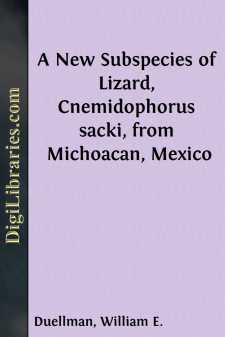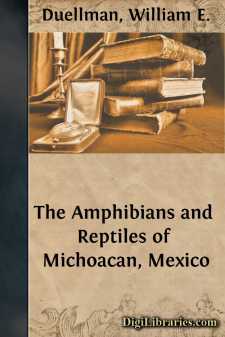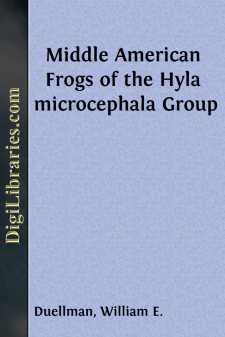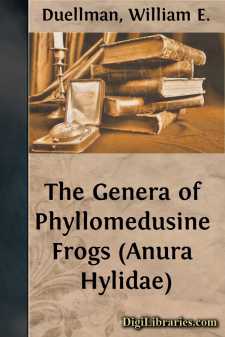Categories
- Antiques & Collectibles 13
- Architecture 36
- Art 48
- Bibles 22
- Biography & Autobiography 813
- Body, Mind & Spirit 142
- Business & Economics 28
- Children's Books 15
- Children's Fiction 12
- Computers 4
- Cooking 94
- Crafts & Hobbies 4
- Drama 346
- Education 46
- Family & Relationships 57
- Fiction 11828
- Games 19
- Gardening 17
- Health & Fitness 34
- History 1377
- House & Home 1
- Humor 147
- Juvenile Fiction 1873
- Juvenile Nonfiction 202
- Language Arts & Disciplines 88
- Law 16
- Literary Collections 686
- Literary Criticism 179
- Mathematics 13
- Medical 41
- Music 40
- Nature 179
- Non-Classifiable 1768
- Performing Arts 7
- Periodicals 1453
- Philosophy 64
- Photography 2
- Poetry 896
- Political Science 203
- Psychology 42
- Reference 154
- Religion 513
- Science 126
- Self-Help 84
- Social Science 81
- Sports & Recreation 34
- Study Aids 3
- Technology & Engineering 59
- Transportation 23
- Travel 463
- True Crime 29
A New Subspecies of Lizard, Cnemidophorus sacki, from Michoacan, Mexico
Description:
Excerpt
Top of head and nape dusty brown; tip of rostral and lateral edges of superciliaries dark cream-color; upper labials and sides of head anterior to eyes cream-color, mottled with blue; lower labials and postocular region pale blue; mental, postmental, and sublabials cream-color. Upper surfaces of forelimbs dull bluish gray, spotted with pale greenish yellow; dorsal surfaces of proximal one-fourth of tail light brownish gray turning to pale orange-brown posteriorly; lateral surfaces of tail bluish gray anteriorly and creamy brown posteriorly. Nuchal region light bluish gray; flanks dark gray; dorsal ground-color dark brown, somewhat paler posteriorly. Body having a row of cream-colored spots in place of a lateral stripe, and another row in place of dorsolateral stripe; dorsally, large diffuse tan or light green spots partially fused and tending to form irregular transverse markings. Chin to posterior end of sublabials pale pink, bordered posteriorly by bluish white area, and then pink. Mesoptychials, under surfaces of hind limbs, and belly cream-colored; anterior edges of belly scales dark blue; lateral two rows of ventrals on posterior two-thirds of body dark blue having light blue or cream-colored spots. Under surfaces of forelimbs bluish cream; ventral surface of tail cream-colored.
Variation in Size and Scutellation.—The largest male has a snout-vent length of 132 mm., the largest female, 114 mm., and the smallest juvenile, 34 mm. The number of dorsal granules at the midbody varies from 91 to 117 (106.2 ± 0.43); the ratio of the number of granules between the paravertebral stripes to the number of granules around the body (PV/GAB) varies from 0.064 to 0.157 (0.097 ±0.007); the number of femoral pores varies from 32 to 49 (41.1 ± 0.20). Usually there are only three enlarged preanals, but 18 specimens have a somewhat enlarged scale anterior to the normal complement of three. In 15 specimens the supraorbital semicircle-series terminate short of the posterior edge of the frontal; in the others the series reach the frontal.
Variation in Coloration.—The coloration of juveniles and subadults varies little; large adults vary considerably especially in the amount of diffusion of the light green middorsal area. In some individuals the vertebral pale area does not include the paravertebral spots; in other individuals the pale area includes not only the paravertebral rows, but, at least anteriorly, the dorsolateral rows. In large males of about equal size (and collected at the same time) there is considerable variation in the amount of blue on the belly. In a few of the males the belly is white with only the anterior edge of each scale blue; in some only the lateral rows of ventrals on the posterior two-thirds of the body are blue; in others all of the posterior two-thirds of the belly is blue.
Ontogenetic Change in Color Pattern.—The metamorphosis of color pattern in Cnemidophorus sacki zweifeli results in the dorsal ground-color becoming paler with age, the replacement of the stripes by spots, and finally in large males the suffusion of these spots.
A single hatchling (UMMZ 114732) is available; this specimen has a prominent umbilical scar and a snout-vent length of 34 mm. The top of the head is olive brown; the dorsal surfaces of the limbs are dark brown with cream mottling; the dorsal ground-color is brownish black; this is paler on the lower flanks. The lateral and dorsolateral stripes are cream-colored; the paravertebral stripes are white. There is a faint, diffuse vertebral stripe anteriorly (). The throat and undersides of the limbs and tail are cream-colored; the belly is bluish white. In life the stripes were pale yellowish green, and the tip of the tail was pink.
In larger individuals the dorsal is dark brown; the lower flanks are grayish tan. Light brown diffuse spots are present in the lateral and dorsolateral dark fields. The tan vertebral stripe is diffuse and nearly fills the paravertebral dark fields; the paravertebral stripes are faint posteriorly; throughout their length they are scalloped—the beginning of their fragmentation into spots ().
In subadults (± 80 mm. snout-vent length) the paravertebral stripes are fragmented into spots posteriorly. Also, the dorsolateral stripes in some individuals are fragmented posteriorly....









